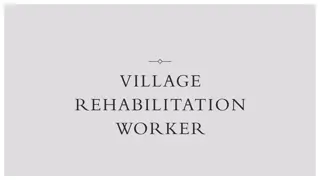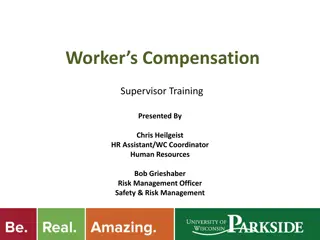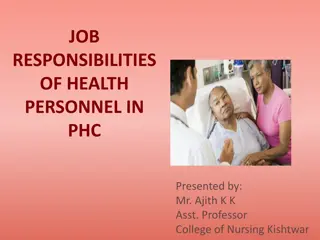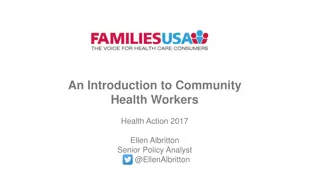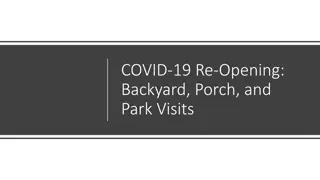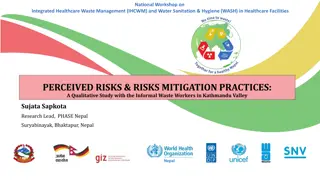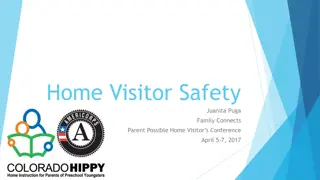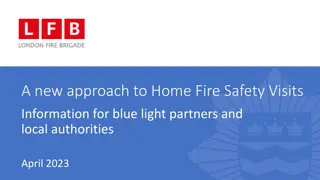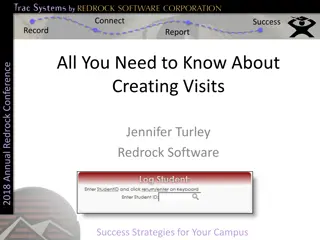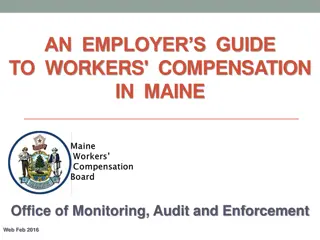Essential Guide to Conducting Safe and Effective Home Visits for Community Health Workers
Learn the key aspects of conducting home visits as a community health worker, including defining home visiting, preparing for visits, assessing safety concerns, addressing challenges, and handling different client environments. Safety guidelines and protocols for encountering various situations during home visits are also discussed.
Uploaded on Sep 11, 2024 | 0 Views
Download Presentation

Please find below an Image/Link to download the presentation.
The content on the website is provided AS IS for your information and personal use only. It may not be sold, licensed, or shared on other websites without obtaining consent from the author. Download presentation by click this link. If you encounter any issues during the download, it is possible that the publisher has removed the file from their server.
E N D
Presentation Transcript
Foundations For Community Health Workers (2016) Berthold, T., Editor San Francisco, C.A.: Jossey-Bass Chapter Eleven Home Visiting
Reflection of Last Session What did you learn? Care management Goal setting
What You Will Learn Define home visiting and provide examples of when and why they are conducted Prepare for home visits Identify key safety concerns and plan for ways to address them Discuss what to do (and what not to do) when you arrive at a client s home Conduct a subtle assessment of the home environment, and explain why this is important Identify and respond to common challenges related to home visits
Home Visiting Meeting clients where they live: An apartment Home Trailer Single-room occupancy hotel A shelter Jail Homeless encampment On the streets In the park
Home Visiting Home visits are conducted with clients: Who find it difficult to meet elsewhere At home because it helps promote their health Who are in the hospital, jail, or other confined institution To assess their home environment To provide support
Prepare for Home Visits Shadow another CHW s home visit Ask client how you can preserve privacy Review and prepare client s files Organize and pack resources to bring Plan how to get to the client s home Identify key objectives of the visit beforehand Dress for the occasion Practice cultural humility
Conducting Home Visits: CHW Interview
Safety Guidelines for Home Visits Concerns include: Witnessing violence and other illegal activity Observing signs of neglect or abuse The need to report harmful or abusive conduct Damage to your car Unintentional involvement in police actions Witnessing domestic violence Threats and assault Meeting an angry/aggressive/threatening person
Safety Guidelines for Home Visits Be prepared: Find out information about the location Work with a partner Let your supervisor know about visit Bring a cell phone Dress appropriately If conflict or danger arises: De-escalate the situation if possible Apologize Leave if you feel unsafe Report violence to your supervisor and document in your notes Call the police only if it is absolutely required
How to Conduct a Home Visit Once you introduced yourself and are invited into the home, confirm that you are talking to the client or primary caregiver. Conduct an assessment of client s: Knowledge, strengths, risks, and needs Health status Adherence to treatments Progress with risk-reduction Health condition Signs and symptoms Recent test results Upcoming appointments Explain why you are having the visit and ask what the client would like to accomplish.
How to Conduct a Home Visit 1. Once you introduced yourself and are invited into the home, confirm that you are talking to the client or primary caregiver. 2. Explain why you are having the visit and ask what the client would like to accomplish. 3. Conduct an assessment of client s: Knowledge, strengths, risks, and needs Health status Adherence to treatments Progress with risk-reduction Health condition Signs and symptoms Recent test results Upcoming appointments
Conducting an Environmental Assessment Observe what is in sight and ask the client s permission to look at other parts of the home. Do you mind if I look in the kitchen to see what you have to eat? Your goal is: To help clients to identify any risks to their health. To work with clients to make changes to their environment that reduce these risks. This include: Assisting clients to organize their medications Reporting mold to the landlord
Common Challenges Visits to people without homes: Be respectful of their space whether its an overpass or a park Keep communication confidential, your voice low, and follow your client s lead When clients are angry: Be patient, stay respectful, professional, and polite If the client is acting in a threatening manner, leave
Common Challenges Clients who are incarcerated: Gain security clearance and maintain professional relationships with staff Assist clients in making plans for when they are released Help them figure out how to reduce their risks
Practice Visit: http://homvee.acf.hhs.gov/mo dels.aspx Discover a tip or suggestion in one of the model programs. Come prepared to share. Complete Chapter 11 HW & DB on Blackboard Read Chapter 12
Resources: Image on slide 2 digital-drugs-binaural-beats by digitalbob8 is licensed under CC BY 2.0 Image on slide 3 Bring Light Bulb is available in the public domain under CC0 Public Domain Image on slide 4 Sioux Falls Jail by Incase is licensed under CC BY 2.0 Image on slide 5 Home is available in the public domain under CC0 Public Domain Video on slide 7 Conducting Home Visits: CHW Interview, Foundations by Foundations for Community Health Workers is licensed under a Standard YouTube License Image on slide 14 WHS Front Door is available in the public domain
Acknowledgements: Adapted from the Foundations for Community Health Workers, 2nd Edition (Berthold) with permission from Wiley Publishing by the Institute of Workforce Innovation of the Metropolitan Community College Kansas City and the Workforce Solutions Group of St. Louis Community College. MoSTEMWINs This product is partially funded by the MoSTEMWINs $19.7 million grant from the U.S. Department of Labor Employment and Training Administration. The product was created by the grantee and does not necessarily reflect the official position of the U.S. Department of Labor. The Department of Labor makes no guarantees, warranties, or assurances of any kind, express or implied, with respect to such information, including any information on linked sites and including, but not limited to, accuracy of the information or its completeness, timeliness, usefulness, adequacy, continued availability, or ownership Unless otherwise noted this material by St. Louis Community College is licensed under a Creative Commons Attribution 4.0 International License.








